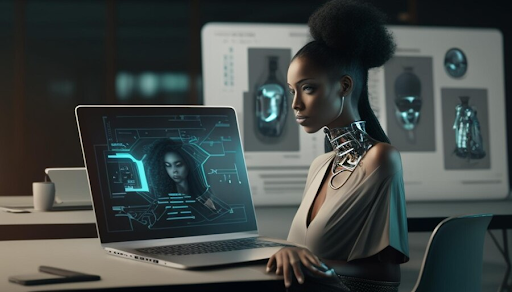How AI Is Revolutionizing Digital Content Creation Through Clothing Changes and Face Swaps

Introduction
Artificial Intelligence (AI) has proved to be an essential part of innovation in the digital content creation process, transforming the way that the creators, marketers and general consumers create, manipulate, and alter visuals. Building a cinematic presentation in video editors, influencers curating outfits to suit what they want to be seen in online, and other actions people can have a lot less time and expertise in but use AI to do it all, anyway. Two of the most remarkable apps, namely AI clothes changers and AI-based face swap features, are rapidly gaining popularity as they provide the power of professional studios.
With technological development, these tools are becoming quicker, more effective, and visually stunning in the creation process of content and bring more concerns about ethics and authenticity.
AI Clothes Changer: Redefining Wardrobe Edits in Visual Media
AI Clothes Changer has created new opportunities for designers of clothes, marketers, influencers, and photographers. Fashion and clothing-based tools, such as the AI-powered clothes changing software, allow users to retouch their clothing virtually and eliminate the necessity of changing the clothing in real life after taking photos and videos and spending money on photo shoots.
The AI can realistically fit new clothing styles to the human body by studying its shape curves, the light and texture of the object they need to be overlaid on. The fashion industry is particularly beneficial to such technology. Designers will be able to display whole collections of clothes on one model and exchange the clothes immediately, without another shoot. It is employed by e-commerce stores so that customers can view clothes in various body shapes.
It also helps content creators improve their digital image since they can experiment with different outfit looks without actually altering clothes, which accelerates the production process. The accuracy of these virtual clothing swaps increases, although taking into consideration cloth movement and alignment as well, AI models continue to grow progressively more sophisticated.
Simplifying Video Editing with AI Tools
AI-based video editing has transformed the video editing concept, which was otherwise laborious and could only be done by professionals. The editing programs have become automated to discern scenes, add a transition, balance the colors, or even make music compatible with the visual pace.
These advancements cut the amount of time in the editing suites and enable creators to leave technical considerations to concentrate on the story. Real-time background replacement, voice syncing and emotions recognition are also possible with AI and it is widely used in marketing, education and entertainment use cases.
To You Tubers and social media influencers, this is a game changer. It implies that one raw material can be reused across the platforms, and AI provides content to other vertical video formats, aspect ratio, and so on. This automation will increase its productivity and also have a consistent quality in all its output in digital form.
The Role of AI in Enhancing Photo Editing Precision
Photo editing programs using AI have gained huge popularity due to their accuracy, facility, and artistic potential. Whether removing the background or repairing a damaged image, AI can target minute details in the photo, such as single hair strands or the lighter shade of skin. Object recognition, auto-enhancement, and style transfer are only some of the tools that are here to facilitate the process.
To photographers and graphic designers, this would require fewer efforts to be invested on menial jobs such as masking or retouching. Whole parts of a scene such as the sky, buildings or the effect of light can be created by AI, which then fits in a pre-existing composition seamlessly.
The reason it would be especially attractive to branding agencies is the ability to design the marketing visuals quickly and fast, without employing large production personnel. In addition, amateur photographers who have not received professional training can make high quality pictures with a few clicks, making art democratic.
Face Swap: Blending Identities with AI Precision
One more innovation in digital media that can be called revolutionary is the so-called Face Swap effect: AI is used nowadays to substitute the face of one person with the face of another one within photos or videos. It implements deep learning algorithms to identify facial landmarks, pair expressions and mix skin colors to achieve a very realistic result.
Such face swap technology was typically called upon to facilitate entertainment in the form of memes or film imitations, but recently has also been utilized in games, marketing, or even virtual learning experiences. An example is that actors are currently digitally able to play many different roles in the same scene (it is possible to place their faces in an iconic movie sequence), or users appear with their face in their favorite movie clip.
In games, avatars can be customized with their own features of the face. As much as the tech is extremely powerful, its emergence has led to ethical debate concerning the misinformation and misuse of identity. This is because there is a growing need to exercise responsible use, clarification, and regulations in order to make the innovations creative but not fraudulent.
Combining AI Tools for Dynamic Digital Storytelling
The true potential of AI in the digital context of the creation of content is making it possible to mix various instruments in order to make storytelling more immersive. An AI clothes changer can help a creator reveal a character that is changing its style with time, whereas a face swap tool can help several people to perform a scene without participating in it directly.
Combined with AI-enhanced voiceovers, emotion tagging and gesture recognition, these tools create a complementary system of interactive storytelling. This synergy can be of great assistance in marketing and social campaigns where the swiftness to work out the trends is essential. Brands can launch partially localized campaigns, replacing faces with others, or changing the clothes to suit the specific region without any additional image shooting.
On the same note, teachers and other trainers employ the technologies to come up with interesting learning platforms where images can be changed in accordance to the desire or culture of the learner. The mobility and the multi-purpose nature of artificial intelligence solutions are changing with the manner in which stories are being presented in the different industries.
The Future of AI in Visual Content Creation
Since AI is getting more and more mature, soon, the limits of what can be done in photo and video editing will extend. Even future devices can provide us with real-time AR filters, completely interactive digital face personas, or even AI generated scenes with the help of the simple text prompt.
The possibility that, with the coming of neural rendering and generative AI, in the future we will be able to create content that involves a virtually complete video in terms of script, cast, wardrobe, and set of locations, generated with only slight human intervention, is now a possibility. This comfort however has to be checked by responsibility.
In the future, it is important to stencil AI-based art and use consent checks in face swapping and educate users on the morality of such actions. And yet, it cannot be disputed that AI is providing a playing field of creativity in which people and small groups can create something on par or better in terms of high-budget productions. Digital storytelling will be a prospective and willing field to pursue with the persistence of innovation and prudent supervision.
Conclusion
The emerging domain of AI-assisted software such as the AI Clothes Changer and Face Swap is transforming the reality of digital creation. They are flexible in a way never seen before as creators can quickly adapt to different audiences, platforms and objectives of their visuals. On the one hand, there is so much that can be done with the technologies; on the other hand, they introduce ethical issues that need to be addressed with responsibility. With the further advancement of AI, it is essential that developers, users, and regulating authorities collaborate in establishing the creative ecosystem that will be innovative and trustworthy.
Are you a fashion brand, social media influencer, a film maker or just a casual content creator; once you use AI as a part of your toolkit, a whole new world of creative opportunity will open up before you, and it is something that people could not have dreamed of just a few years back.



